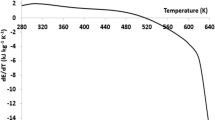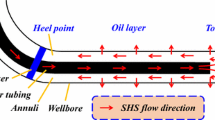At present, hydrodynamic models do not allow simulation of local effects of thermal fields with sufficient accuracy, and integral models do not take into account the steam mass fraction in the heat transfer fluid. The purpose of this work is the analysis of the influence of thermophysical parameters of the reservoir and fluid on the optimal times of stages of cyclic steam stimulation of the reservoir and of additional maximum cumulative oil recovery. For the first time, an integral mode has been developed for cyclic steam stimulation, accounting for the steam mass fraction in the heat transfer fluid and the equation of state for water. The model is based on the use of heat balance relationships for each type of cyclic steam stimulation. The steam temperature in the production interval, the initial reservoir temperature, and the heat flux are determined by the data from short-term dynamic temperature studies. The oil flow rate is determined by the Dupuis formula for a zone-heterogeneous reservoir. Optimal times for cyclic steam stimulation stages and the maximum cumulative oil recovery have been determined. It is shown that the optimal time of the heat transfer fluid injection to the reservoir and the time of steam soak for the well increase with increase in the reservoir thickness, the heat transfer fluid flow rate, and the steam mass fraction in it. Limits have been identified to the applicability of cyclic steam stimulation in terms of the heat transfer fluid flow rate.
Similar content being viewed by others
References
H. **ong, S. Huang, D. Devegowda, H. Liu, H. Li, and Z. Padgett, Influence of pressure difference between reservoir and production well on steam-chamber propagation and reservoir-production performance, SPE J., 24, No. 2, 452–476 (2019).
A. Ya. Gil'manov, K. M. Fedorov, and A. P. Shevelev, Mathematical modeling of the process of steam-assisted gravity drainage during the extraction of high-viscosity oil, J. Eng. Phys. Thermophys., 94, No. 3, 592–601 (2021).
C. C. Ezeuko and I. D. Gates, Thermal oil recovery from fractured reservoirs: Energy and emissions intensities, Energy, 155, 29–34 (2018).
A. A. Lipaev, Development of Heavy Oil Fields and Natural Bitumen Deposits [in Russian], ANO “Izhevskii Institut Komp′yuternykh Issledovanii,” Izhevsk, Moscow (2013).
B. Swadesi, S. A. Muraji, A. Kurniawan, I. Widiyaningsih, R. Widyaningsih, A. Budiarto, and B. M. Aslam, Optimizing the development strategy of combined steam flooding and cyclic steam stimulation for enhanced heavy oil recovery through reservoir proxy modeling, J. Pet. Explor. Prod. Technol., 11, No. 12, 4415–4427 (2021).
Z. Al Yousef, H. Al Daif, and M. Al Otaibi, An overview of steam injection projects in fractured carbonate reservoirs in the Middle East, J. Pet. Sci. Res., 3, No. 3, 101 (2014).
F. Sun, Y. Yao, and G. Li, Effect of bottom water on performance of cyclic superheated steam stimulation using a horizontal well, J. Pet. Explor. Prod. Technol., 9, No. 3, 2291–2296 (2019).
R. S. Khisamov, E. F. Zakharova, D. M. Gumerova, and V. A. Sayakhov, Comprehensive investigations of the composition and properties of bituminous oil from the Ashalchinskoye oil field, Neft. Khoz., No. 10, 68–71 (2018).
M. B. Savchik, D. V. Ganeeva, and A. V. Raspopov, Improving the efficiency of cyclic steam stimulation of wells at the Upper Permian deposit of the Usinskoye oil field on the basis of a hydrodynamic model, Vestn. PNIPU, Geol. Neftegaz. Gorn. Delo, 20, No. 2, 137–149 (2020).
J. J. Taber, F. D. Martin, and R. S. Seright, EOR screening criteria revisited — Part 1: Introduction to screening criteria and enhanced recovery field projects, SPE Reservoir Eng., 12, No. 3, 189–198 (1997).
F. Sun, Y. Yao, and G. Li, Effect of horizontal heterogeneity on productivity of cyclic superheated steam stimulation horizontal wells: Numerical analysis, J. Pet. Explor. Prod. Technol., 9, No. 3, 2319–2324 (2019).
H. A. Lauwerier, The transport of heat in an oil layer caused by the injection of hot fluid, Appl. Sci. Res., 5, No. 2, 145–150 (1955).
J. Jones, Cyclic steam reservoir model for viscous oil, pressure depleted gravity drainage reservoirs, Conference Paper SPE 6544 from the SPE California Regional Meeting, 13–15 April 1977, Bakersfield, California, USA (1977).
T. C. Boberg and R. B. Lantz, Calculation of the production rate of a thermally stimulated well, J. Pet. Technol., 18, No. 12, 1613–1623 (1966).
P. J. Closmann, N. W. Ratliff, and N. E. Truitt, A steam soak model for depletion type reservoirs, J. Pet. Technol., 20, No. 6, 257–270 (1970).
Z. Wu and S. Vasantharajan, Optimal soak time for cyclic steam stimulation of a horizontal well in gravity drainage reservoirs, Conference Paper SPE 146716 from the SPE Reservoir Characterisation and Simulation Conference and Exhibition, 9–11 October 2011, Abu Dhabi, UAE (2011).
R. D. Seba and G. E. Perry, A mathematical model of repeated steam soaks of thick gravity drainage reservoirs, J. Pet. Technol., 21, No. 1, 87–94 (1969).
É. M. Khramchenkov and M. G. Khramchenkov, Mathematical model of multiphase nonisothermal filtration on deformable porous media with a simultaneous chemical reaction, J. Eng. Phys. Thermophys., 93, No. 1, 191–200 (2020).
A. Ya. Gil'manov, T. N. Koval′chuk, and A. P. Shevelev, Physicomathematical modeling of cyclic steam stimulation of oil reservoirs, Vestn. Tyumen. Gos. Univ., Fiz.-Mat. Model. Neft. Gaz. Énergetika, 6, No. 1 (21), 176–191 (2020).
J. W. Marx and R. H. Langenheim, Reservoir heating by hot fluid injection, Trans. AIME, 216, No. 1, 312–315 (1959).
E. R. Likhachev, Equation of fluid state, Vestn. VGU, Ser. Fiz. Mat., No. 3, 41–48 (2014).
R. L. Fogel′son and E. R. Likhachev, Temperature dependence of a fluid volume, Zh. Tekh. Fiz., 79, No. 7, 156–158 (2009).
National economy facilities in underground mine workings, Construction Rules and Regulations SNiP 2.01.55-85 [in Russian], Gos. Kom. SSSR po delam stroitel′stva, Moscow (1986).
K. S. Basniev, I. N. Kochina, and V. M. Maksimov, Underground Hydrodynamics [in Russian], Nedra, Moscow (1993).
Author information
Authors and Affiliations
Corresponding author
Additional information
Translated from Inzhenerno-Fizicheskii Zhurnal, Vol. 96, No. 5, pp. 1323–1331, September–October, 2023.
Rights and permissions
Springer Nature or its licensor (e.g. a society or other partner) holds exclusive rights to this article under a publishing agreement with the author(s) or other rightsholder(s); author self-archiving of the accepted manuscript version of this article is solely governed by the terms of such publishing agreement and applicable law.
About this article
Cite this article
Gil′manov, A.Y., Shevelev, A.P., Lagunov, P.S. et al. Influence of the Thermophysical Properties of the Reservoir and Fluid on the Technological Parameters of the Cyclic Steam Stimulation. J Eng Phys Thermophy 96, 1311–1319 (2023). https://doi.org/10.1007/s10891-023-02797-8
Received:
Published:
Issue Date:
DOI: https://doi.org/10.1007/s10891-023-02797-8




